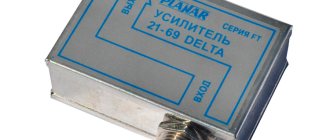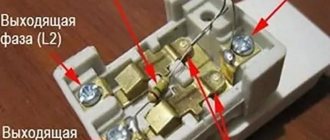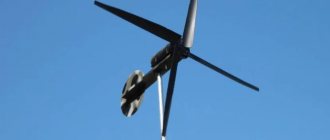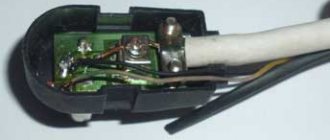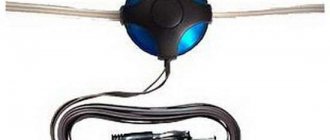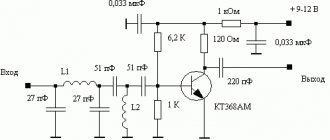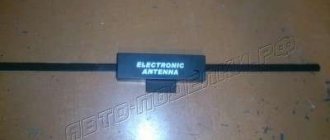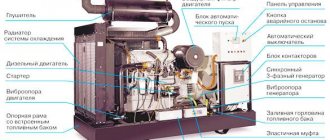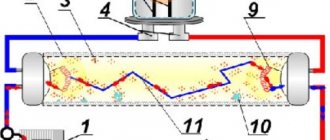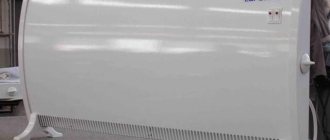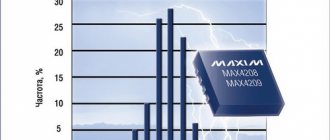Last updated January 2, 2022
A television antenna amplifier is a specialized device designed to increase the power of an electromagnetic wave pulse. In other words, the main task of the device is to amplify a television or radio signal.
The advantages of antenna amplifiers include signal filtering, which leads to reduced interference and improved quality of certain ranges.
Below is a rating of the best TV antenna amplifiers that you can buy in 2022.
Content:
- 1 What affects signal quality
- 2 Signal amplification methods
- 3 What is an antenna amplifier 3.1 Equipment design
- 3.2 Operating principle
- 3.3 Advantages and disadvantages
- 3.4 How to choose amplifiers for TV
- 3.5 7 good signal boosters
Modern TV channels are broadcast in digital format via satellite dishes, cable, and Internet TV. The quality of the latter depends on the speed of your Internet connection. When receiving a signal from a satellite, the antenna is automatically or manually adjusted and an amplifier is connected. But few people think that terrestrial television often requires special equipment to improve signal quality. This equipment is an antenna amplifier for TV.
Let's figure out when signal amplification is needed, which affects its quality. And also the TOP 7 purchased antenna equipment, and how to create it yourself.
Review of popular models
Some amplifiers are in demand due to their simple design, low cost and easy installation. If necessary, the devices can be installed, replaced or repaired yourself.
Image gallery
Photo from
EUROSKY SWA-555
Planar 21-69FT
Locus LA-21
Terra 126
When purchasing devices for external use, take care of their tightness. It has been noted that external devices have to be replaced approximately once every 2 years, despite their protection, so if it is possible to install the amplifier under the roof, take advantage of it.
What affects signal quality
Digital terrestrial television is broadcast from a common repeater. Satellite dishes receive the signal from the satellite and send it to the set-top box for decoding. As a result of any of the options, users watch a minimum of 20 basic channels in digital quality on TV.
Signal transmission interference is:
- Distant location of the central repeater;
- The antenna for satellite or terrestrial TV is incorrectly selected;
- Presence of natural noise;
- There is a lot of interference on the signal path: trees, high-rise buildings;
- The cable is mechanically damaged;
- The transmitter orientation is incorrectly configured;
- Old equipment cannot cope with the new format;
- Weather, atmospheric influences;
- External interference, for example, the location of metallic interference near the antenna;
- The TV signal is divided into several devices simultaneously.
Advice. Before purchasing or assembling a TV signal amplifier, you must visually inspect the cable, check that the settings and equipment connections are correct.
"Folk" methods of signal improvement
In general, you can boost the signal of TV antennas with your own hands, without purchasing an amplifier. There are several ways to deal with this:
- Change the direction of the antenna. Perhaps it is simply turned in the opposite direction, and the repeater signal does not reach completely. Move it 1-2 degrees until the quality improves. You will have to act “at random,” but often the problem lies precisely in the location of the receiver.
- Increase the number of antennas. Also an effective method, although it will cost more than buying an amplifier. It is necessary to place several antennas at the same height, pointing at one point. In this case, the signal may improve, although not much.
- Buying a more powerful antenna. Also a good option, especially if you live far from the repeater.
- Shield the antenna. In this case, it is necessary to place some kind of reflector at the back (a common option is a beer can cut in half). It will reflect the waves and collect them on the “antennae”.
As you can see, you can amplify a television signal without an amplifier, although it will be either more expensive or less effective.
Signal amplification methods
Before purchasing an antenna amplifier for your TV, you can try to adjust the signal quality using the following methods:
- Change the location of the antenna. More precisely, point it towards the transmission tower.
- Increase the number of antennas to improve signal quality. They must be installed at the highest point. If this is a private house, then on the roof.
- Buy a more powerful satellite or terrestrial antenna, check the version of the set-top box.
- Remove all metal objects located near the receiver or antenna.
- Create a common-mode antenna array (CAP) effect. The goal is to make the signal phases the same.
Important! Check the version of the receiver (set-top box). If it is outdated or not designed to receive a digital signal, the steps described above will not help. Also, the TV signal amplifier will not work.
Why do you need a signal amplifier?
If the TV does not operate from cable or a satellite dish, it means that it receives the signal using a regular antenna - indoor or outdoor. The transmission process occurs as follows: towers relaying transmissions are installed at a certain distance from each other.
Household receivers - televisions - use an antenna to catch signals and convert them into video accompanied by sound.
A good signal is created in line of sight conditions. If there are obstacles in its path in the form of, for example, reinforced concrete structures, then the quality of image and sound drops sharply
To stabilize and improve the TV signal, an amplifier is used for a home television antenna. Its importance increases where there is no common powerful receiver installed on the roof, that is, outside the city. The device helps to achieve maximum clear images on the screen and purity of sound due to the fact that it reduces interference.
Some antennas cope with signal transmission on their own, without connecting additional devices. Therefore, before purchasing, study the technical characteristics of the antenna and make sure that its capabilities are limited, and it is not possible to configure it to obtain high-quality image and sound without connecting a special device.
What is an antenna amplifier
Antenna amplifier for digital television - devices that amplify the television signal. They are used in private houses, apartments located in small towns and even megacities. With their help, it is possible to enhance certain ranges of TV signals and reduce the level of existing interference. As a result, the picture on the screen becomes clear and stops flickering or disappearing. The sound quality is also improved.
Devices are classified according to the type of fixation:
- Mast-mounted, mounted on a mast. Power is supplied to it via a coaxial cable. The devices amplify the TV signal well, but are not durable due to the type of fixation. After all, the device is exposed to precipitation.
- Internal is a common type of amplifier that provides the desired gain. It is fixed next to the receiver. But the quality of the signal that reaches the device is affected by the cable itself.
Also, antenna signal amplifiers for TVs are classified by range or settings: broadband, range (SWA, LSA devices for array antennas), multi-band (ALCAD, TERRA series for long-range and close-range receivers).
All cable TV amplifiers use an internal regulated or external unregulated power supply. In simple words, they operate on electricity via a cable or a built-in battery.
Equipment design
Amplifiers are small circuit boards with built-in amplification stages. Externally, these are boxes with connectors for connecting to equipment. The circuits ensure signal stability and reduce interference.
Some device models are equipped with internal controllers responsible for adjusting power and gain. Potentiometers and filters are installed between them to generate a signal with the desired frequency response.
Important! Any digital TV signal amplifier runs on electricity. The equipment set must include a power source or unit with an input of 220 V, an output of 12 or 24 V (possibly less).
Principle of operation
Consider a simple SWA 32 model, which has 2 broadband amplification stages (VT 1 and 2). The signal from the antenna goes through the transformer in the antenna box to the capacitor and the first transistor (VT1). It amplifies the signal and stabilizes the operating point. The resulting linear signal is supplied to transistor 2 through the second capacitor. And it intensifies again. And only then is it sent to the TV receiver for decoding.
Advantages and disadvantages
The digital television signal amplifier has the following advantages:
- Significant improvement in broadcast quality;
- Ability to tune channels with weak signals;
- Signal improvement over a wide frequency range;
- Reducing the influence of external interference, including weather conditions.
The disadvantages of the devices include severe overheating due to good signals in the range of 49-230 MHz. For example, the television provider installed an additional repeater or improved the transmission quality indicators. This surge led to overheating and failure of the home amplifier. Severe thunderstorms lead to the same consequences.
How to choose amplifiers for TV
Broadcast waves are in the range of meter (MV) and decimeter (UHF) frequencies. The indicator of the first is from 30 to 300 MHz, the second is from 3000 to 3000 MHz. A television antenna signal amplifier can operate in two latitudes at once or in one (band). Moreover, a narrowly focused device copes with its responsibilities better than a broadband or multi-band one.
Important! All digital channels are broadcast in DVB-T2 format. They only work in the UHF range. Therefore, modern amplifiers must meet this indicator.
Other selection criteria include:
- The recommended signal reception range is from 30 to 150 km. This is the distance that is between the antenna itself and the transmitter.
- Gain. Don't think that more is better. The optimal indicator is 27 dB. The device is suitable for a range of up to 50 km. When the distance to the translator is greater, you can choose a 40 dB model, which provides good signal reception even in difficult weather conditions. But if you install too powerful equipment, the built-in protection in the TV or set-top box will work, blocking the broadcast.
- Power supply system – mains or battery. You can choose a model that is installed complete with an attachment. It will be powered from the same cable as the main equipment.
- Execution and type of housing. For an apartment, you can choose plastic amplifiers. For street fixing, protection from precipitation is important.
Advice. Pay attention to the attachment. Many modern options come with a port for connecting an amplifier with power over a signal cable. This is the simplest option for connecting equipment.
7 good signal boosters
Among the amplifiers for your indoor TV antenna, you can choose an option that is affordable and of high quality. According to customer reviews, the following 5 models are well suited for a private house and apartment:
- Model SWA9001/999/9701 (L) broadband. No adjustments are provided. Connects to the antenna and is powered via a signal cable. Can be installed on indoor or outdoor antennas. But in the second case, additional protection from external influences will be required. Reception range up to 00 km. Suitable for color digital signal.
- Italian Televes amplifier with five outputs. The gain is small - 16 dB, but noise and interference are low. It is powered by a separate unit included in the kit.
- Gecen A05-02 – suitable for terrestrial and satellite TV. The operating range is within 950-2400 MHz (for satellite) and 5-950 MHz. It is powered via a coaxial cable, meaning there is no need to plug in the device additionally.
- RTM LNA02 amplifier for set-top boxes with power on the port. Advantages: low level of extraneous noise. Optimal for medium reception area. The maximum gain is 20 dB. Suitable for all types of antennas. Installation on the F-connector without adjustments.
- Alcad Al-200 is a popular device with safe use. Suitable for apartments (indoor spaces). Effort factor – 24 dB. Connects to a 220 V power supply. Provided for an outlet, which simplifies the connection.
- Wisi VM 8351 is a fairly powerful mast-type amplifier. Installed outdoors. Tolerates difficult weather conditions. The kit includes its own power supply with a transition from 220 V to 24 V. The gain can be adjusted from 15 to 35 dB. Connects using F-connectors. The package includes one input and 2 outputs.
- Terra HA126 apartment amplifier with a gain of up to 20 dB. Adjustments are provided to adjust the quality on all channels. Low transmission of noise interference. Refers to broadband equipment with frequencies from 47 to 862 MHz. The kit includes a test port for tuning the antenna.
All of the options listed are connected according to the instructions and are suitable for broadcasting digital television.
Types of antenna amplifiers
Antenna amplifiers come in several types:
Internal. They differ in the average increase coefficient. Very convenient to use. This is due to the fact that the internal amplifiers are located as close as possible to the receiver
Mast. A more powerful option that connects using a coaxial cable. Many users note the excellent signal quality. However, the service life is several times shorter than in internal amplifiers. It is also worth noting that mast models do not tolerate moisture well.
Antenna amplifiers can also be divided according to the type of frequencies they receive. Currently the following options exist:
Multi-band. Can be 5 or 12 volt. Separate adjustment of each range is provided. In the first case, the connection is made via a coaxial cable. As for 12-V, they need a power supply to work
Range. Capable of receiving meter (30-300 MHz) and decimeter (300-3000 MHz) frequencies. Ideal for boosting weak TV signals
Broadband. A key feature is coverage of a wide range of amplified frequencies. Designed for cases where a good signal cannot obtain an acceptable image.
How to boost the signal up to 20 channels with your own hands step by step
You can make an antenna signal amplifier yourself. It is a board or stationary device attached to a cable or antenna. The components for creating such a board are common. They can be purchased at any radio equipment store. But assembly will require at least basic knowledge of electronics and soldering of elements.
Here is one of the diagrams for assembling an amplifier for a TV antenna:
- Buy microcircuit max2633 (VT), R=1 kOhm, 1 nF capacitors.
- Additionally, a DC source with a voltage of 2.8 - 5.2 V is purchased.
- The assembly diagram is shown in the photo.
The finished product produces a noise level of about 2 dB and a gain of around 13 dB. This is not enough for the TV receiver to be located far away from the repeater. But it is enough to improve the signal within medium and large cities. The resulting device is suitable only for indoor antennas. And it is designed for a very short range with frequencies up to 900 MHz.
Broadband amplifiers are assembled according to the same principle, but using a different circuit. If control is required, internal controllers are additionally connected. Home electronics technicians can assemble complex devices themselves that match and even exceed the quality of store-bought equipment.
Advice. If you have never soldered microcircuits and did not understand small boards, it is better to buy ready-made equipment. The cost of an amplifier for a home antenna is low. And it doesn’t take much time to connect.
Operating principle of the antenna adapter
TV amplifiers are simple in design and can have different designs. Some consist of a pair of boards on which circuitry is implemented to reduce noise. One of the circuits performs the function of a high-frequency filter, the second is equipped with a capacitor for adjusting frequencies.
To set the required mode, resistors are used. The frequency is adjustable in two ranges: in the first – about 48.5 MHz, in the second – 160 MHz
Thanks to the adjustment, a maximum signal gain of 4.7 dB can be achieved at an operating frequency of 400 MHz.
Some types of amplifiers are designed to be powered from a 12 V source, that is, they can be connected to a car battery. To achieve stability, a stabilizer is used, the circuit of which includes an electrolyte and a diode bridge.
A number of devices are connected using a coaxial cable, but using a choke. They are connected to the TV through a capacitor.
Let's look at the example of one of the transformer amplifier circuits to see how the device works. The module is powered via a signal cable.
The antenna is connected directly to the transformer winding. The amplifying element VT1 is matched to the common emitter. Feedback is provided by elements C1, R3, L1
C1 is a capacitor that connects the feedback section to the power supply and operates at low frequencies. R3 is a resistor that determines the stable operation of the amplifier in various frequency ranges. L1 – inductance that equalizes the frequency amplitude.
Feedback to the flow is organized by circuit C3 , R4 , which together with R1 and R2 enable the cascade mode of operation. C2 is a capacitor that provides connection to the transformer.
The signal from the antenna enters the matching transformer, is then transmitted through a transistor, amplified and stabilized at the emitter. Then frequency correction occurs in the second stage of cascade transistors, after which the signal enters the TV.
If there are several TVs in the house, then a splitter with 3-6 connectors is used to connect the cable and signal amplifier
Thus, thanks to the television amplifier, the sensitivity limited by noise increases, and the loss of the received signal in the coaxial cable is compensated.
How to connect an amplifier without special connectors
The easiest way to boost the signal of a television antenna to improve the quality of digital television broadcasts is to buy a ready-made device that is suitable in terms of parameters and broadcast frequency.
Connecting the equipment is easy. Let's look at a step-by-step diagram based on an open board for an antenna cable that is connected to a clamp:
- Clamp connection – type of connection that is provided on antennas with amplifiers of the SWA series. For example, the Delta series antenna has two spaced contacts. To connect an antenna to them, you need to remove the insulation layer from the cable.
- The insulation layer must be removed in stages. First, the upper cable braid and foil are removed. Then, there may be an additional layer of insulation. But there is only one tourniquet left inside. This is the central core of the cable.
- The central core can be crimped with the contact clamp provided on the amplifiers without modification. You can solder the braid back to the core and contacts to provide a more reliable connection.
Important. When connecting the cable to the clamp, you must determine the correct polarity. This is the only way the assembled circuit will work.
It is easier to connect a cable with a SWA type clamp. There is no need to think about polarity, which reduces the possibility of making a mistake when amplifying a digital television signal to zero. The cable is crimped with a fastening bracket, ensuring reliable fixation. Preparing the wire is the same as the previous instructions - you need to free the central core.
But the most convenient way to connect an antenna amplifier is to use the option with a special F-connector. For connection, the wire is prepared and the antenna plug is installed.
Advice. If you do not know how to prepare cables or fix the central core, it is better to turn to the experts. Calling a specialist to your home will cost no more than 500 rubles. But you will save time and effort on connecting an antenna signal amplifier.
What to look for when choosing an amplifier
Let's look at how to choose antenna amplifiers for a TV. To select a signal amplifier, you need to pay attention to the following parameters:
- Device location. There are mast or external amplification devices, which are installed on the mast, and internal ones - indoors. Using internal antenna amplifiers is much more convenient, but there is also more signal loss. In the UHF it is better to use the mast type;
- Distance to TV tower. The maximum distance should not exceed 150 km, and if less than 10 km there is no need to install an amplifier, it is enough to select and install the antenna correctly;
- Range of frequencies used. If the signal source is weak, then it is better to use a range amplification device for specific frequencies;
- Gain coefficients (GC) and noise of the device. There are special tables for device models where these values are presented. A gain of 15-25 dB is usually sufficient. And the noise figure for UHF should not be more than 3 dB, in other ranges it can reach 6-8 dB;
- Output signal level. This is the maximum signal level above which distortion or interference will occur. The higher this characteristic, the better, but the cost of the device also increases as this parameter increases;
- Number of inputs. If you take an amplifier with several inputs (for each frequency range), then the likelihood of overload increases. It is better to use a separate device for each range.
The gain should not be chosen on the principle of “the more the better.” If the values are too high, the device may overload
What amplification device is suitable for digital TV? For digital broadcasting you need an antenna for UHF with a frequency of 470 MHz or more. Accordingly, the amplifier must also be designed for this range.
Of course, it is impossible to say for sure which device will be the best for your case.
Recently, it has become popular to purchase goods on Chinese websites. Here you can find active antennas with a DVB-T2 amplifier, which are quite acceptable in terms of price-quality ratio.
General recommendations
Before purchasing an antenna signal amplifier, check the quality of the equipment setup, the version of the digital set-top box and the integrity of the cable itself. When using a satellite or terrestrial antenna, you can turn the “dish” towards the broadcast source. And also remove all metal objects located near the antenna.
When choosing an amplifier, it is important to consider the type of source: terrestrial, satellite television. And also pay attention to the frequency, operating range (from 30 to 150 km), and gain. Consider the location of the device: indoors or outdoors.
And remember. You can always call a specialist to your home and consult whether you need an amplifier and what kind of equipment is best to buy.
Found a mistake? Select it and press ctrl+enter
- 60
Basic criteria for choosing television signal amplifiers
The amplifier for the television antenna is selected according to the technical criteria of the device and in accordance with external factors (for example, the location and installation conditions). The most important thing is to take into account the characteristics that affect the quality of the television signal, for which they resort to the use of additional devices.
Operating frequency range
Three devices are associated with the frequency range: a television, an antenna and an amplifier. First of all, the antenna is selected. In this selection, it is necessary to take into account the superiority of narrow-beam over wide-range ones in terms of signal strength.
If the repeater is located close to the reception area, then an “all-wave” unit capable of covering a wider range is suitable. Receiving a signal from a remote television tower will be achievable using a device adapted to a limited frequency range (for example, MV or UHF).
The amplifier is selected in accordance with the frequency response of the antenna. If the range does not match, the existing device will not be able to function.
Noise figure
Using an amplifier, the TV signal-to-noise ratio should be adjusted upward. Taking into account the fact that when transmitting data, each device receives its own noise, as the signal increases, they also become more significant.
It is generally accepted that the value of the noise effect should not be more than 3 dB. Only under such conditions can we talk about guarantees of good quality TV signal transmission. However, newer devices may have a lower value of 2 dB.
Gain
The presence of the highest possible coefficient does not guarantee the best transmission quality. Moreover, with excessive amplification, the TV signal will be distorted with the opposite effect (clipping or overload).
To measure the parameter, dB is used, and its average values are:
- decimeter - from 30 to 40 dB;
- meter - 10 dB.
It follows from this that decimeter channels will have a coverage of 20 to 60 TV channels, and meter ones will have no more than 12. If the gain increases by 15-20 dB, we can talk about a good result.
When choosing an amplifier by coefficient, you need to base it on actual conditions and reception level. As a rule, the distance from the television tower (repeater) is taken into account. If the TV tower is located in direct line of sight, then purchasing an amplifier is not required.
Active or passive antenna
Antennas for receiving television signals can be passive and active:
- a passive antenna receives a signal only due to its own shape;
- for the active antenna , which increases the strength of the useful signal.
The active antenna must be provided with additional power from the network. As a rule, an amplification device is connected using a 9 or 12 V adapter. If the device is located outdoors, then you need to protect it from the rain. Be sure to take into account the information in the manufacturer's instructions warning about the possibility of interference if the device is not installed correctly.
A passive antenna can also be converted into an active one if an amplifier is added to it. This option may be more convenient than buying an antenna with a built-in amplification device - if the amplifier breaks down, it can be easily replaced. You can place it not next to the antenna itself, but in the attic or in a room, which will ensure a longer service life of the device.
DIY active antenna with amplifier for digital TV:
Advantages and disadvantages
Also, before boosting the TV antenna signal, you need to evaluate the advantages and disadvantages.
Advantages:
- Noticeable improvement in picture quality. In general, for certain zones (regions of limited broadcasting, summer cottages, etc.) this is the only way out. Even increasing the number of antennas will not help here.
- It is possible to work with a weak signal, in which the antenna, in principle, cannot display an adequate image.
- Increasing the frequency range. You can find new channels that did not exist before.
- Reducing the amount of external interference.
And the shortcomings of the amplifier are related to its sensitivity. Indeed, the device is very sensitive, which can be aggravated by the following:
- Improving signal quality. Literally, the amplifier can burn out due to the fact that the supplier installed a new repeater closer to the old one. This causes overheating and subsequent damage. If you find out about the launch of a new relay point, simply turn off the amplifier or replace it with a less powerful one.
- Storm. Lightning striking an antenna can literally burn it. However, the receiver will also burn out.
